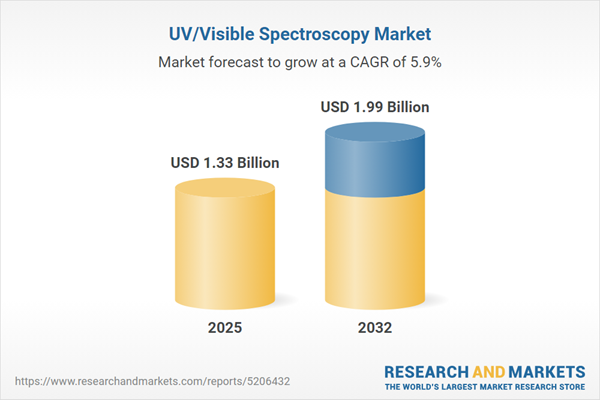Speak directly to the analyst to clarify any post sales queries you may have.
The UV/Visible Spectroscopy Market demonstrates robust growth, propelled by accelerating technological innovation, shifting regulatory landscapes, and evolving end-user requirements across diverse verticals. Senior executives attentive to analytical instrumentation trends will find this analysis essential for future-focused, strategic decision-making.
Market Snapshot: UV/Visible Spectroscopy Market Size and Growth
The UV/Visible Spectroscopy Market advanced from USD 1.25 billion in 2024 to USD 1.33 billion in 2025 and is projected to expand at a 5.91% CAGR, reaching USD 1.99 billion by 2032. Growth is powered by heightened demands for rapid, accurate, and non-destructive analytical techniques worldwide, with significant investments in research, compliance, and industrial process enhancement.
Scope & Segmentation of the UV/Visible Spectroscopy Market
- Instrument Types: Benchtop (including microplate reader, microvolume, and standard systems), Handheld (probe based and self-contained), and Portable (battery powered and USB powered) solutions.
- Wavelength Ranges: Instruments configured for ultraviolet, ultraviolet-visible, and visible spectra, allowing specialized and multipurpose applications.
- Applications: Coverage includes education, environmental analysis, process monitoring, quality control, and research and development, ensuring versatility across industry and academia.
- Technologies: Available options span charge coupled devices, diode arrays, double beam, and single beam architectures that address sensitivity, speed, and stability requirements.
- End User Industries: Academic institutions, chemical manufacturing, environmental consultancies, food and beverage processing, and pharmaceuticals represent the primary sectors of adoption.
- Geographical Markets: Americas (United States, Canada, Mexico, Brazil, Argentina, Chile, Colombia, Peru), Europe, Middle East & Africa (United Kingdom, Germany, France, Russia, Italy, Spain, Netherlands, Sweden, Poland, Switzerland, United Arab Emirates, Saudi Arabia, Qatar, Turkey, Israel, South Africa, Nigeria, Egypt, Kenya), Asia-Pacific (China, India, Japan, Australia, South Korea, Indonesia, Thailand, Malaysia, Singapore, Taiwan).
- Key Companies Profiled: Thermo Fisher Scientific Inc., Agilent Technologies, Inc., Shimadzu Corporation, PerkinElmer, Inc., Metrohm AG, JASCO Corporation, Hitachi High-Tech Corporation, HORIBA, Ltd., Bio-Rad Laboratories, Inc., and Bruker Corporation.
Key Takeaways for Senior Decision-Makers
- Growing industry emphasis on rapid, reliable testing is advancing adoption across pharmaceuticals, environmental monitoring, and manufacturing sectors.
- Instrument evolution is shaped by miniaturization, automation, and user-centric interfaces, enabling adaptation for both laboratory and in-field settings.
- Cloud connectivity and embedded analytics are becoming fundamental for achieving operational efficiency and supporting real-time decision-making.
- Regulatory changes are requiring more robust data traceability, accuracy, and compliance, particularly in regions with stringent oversight.
- Supply chain diversification is now a strategic imperative, as shifts in trade policies and tariffs impact sourcing models and product delivery.
- Innovation partnerships among instrument builders and software providers are driving the integration of predictive analytics and AI-based interpretation capabilities.
Tariff Impact: Supply Chain and Pricing Dynamics
Recent tariff increases by the United States on scientific imports have affected the UV/Visible Spectroscopy Market, raising production and procurement costs for key optical components. Vendors are responding by leveraging alternative regional supply hubs in Asia-Pacific and Europe and investing in local manufacturing to reduce exposure. These trends are prolonging lead times and shifting pricing strategies, leading organizations to reconsider upgrade cycles and service approaches.
Methodology & Data Sources
Insights are derived from detailed primary interviews with laboratory leaders, R&D heads, equipment manufacturers, and thought leaders, supported by robust secondary research. The approach integrates regulatory reviews, manufacturer data, published literature, and expert panel validation, ensuring high-integrity, triangulated findings relevant to market realities.
Why This Report Matters
- Equips senior leaders to make evidence-based investment choices aligned with the UV/Visible Spectroscopy Market’s shifting regulatory and technology trends.
- Highlights market drivers, including automation, compliance requirements, and supply chain strategy—guiding competitive positioning and operational planning.
- Delivers actionable segmentation intelligence, empowering tailored go-to-market strategies across global regions and customer profiles.
Conclusion
The UV/Visible Spectroscopy Market’s evolution is shaped by advanced technology, adaptive regulation, and global supply chain pressures. Decision-makers prioritizing innovation and supply agility will secure advantages in this dynamic landscape.
Additional Product Information:
- Purchase of this report includes 1 year online access with quarterly updates.
- This report can be updated on request. Please contact our Customer Experience team using the Ask a Question widget on our website.
Table of Contents
3. Executive Summary
4. Market Overview
7. Cumulative Impact of Artificial Intelligence 2025
Companies Mentioned
The companies profiled in this UV/Visible Spectroscopy market report include:- Thermo Fisher Scientific Inc.
- Agilent Technologies, Inc.
- Shimadzu Corporation
- PerkinElmer, Inc.
- Metrohm AG
- JASCO Corporation
- Hitachi High-Tech Corporation
- HORIBA, Ltd.
- Bio-Rad Laboratories, Inc.
- Bruker Corporation
Table Information
| Report Attribute | Details |
|---|---|
| No. of Pages | 184 |
| Published | October 2025 |
| Forecast Period | 2025 - 2032 |
| Estimated Market Value ( USD | $ 1.33 Billion |
| Forecasted Market Value ( USD | $ 1.99 Billion |
| Compound Annual Growth Rate | 5.9% |
| Regions Covered | Global |
| No. of Companies Mentioned | 11 |









